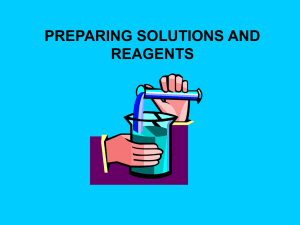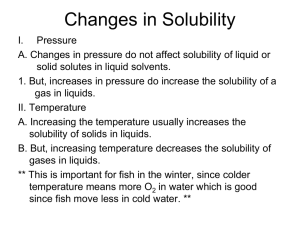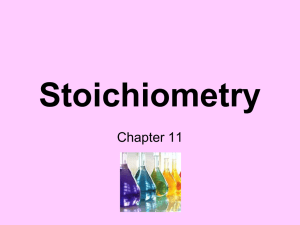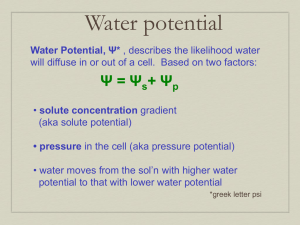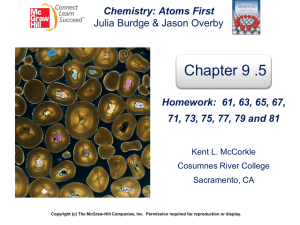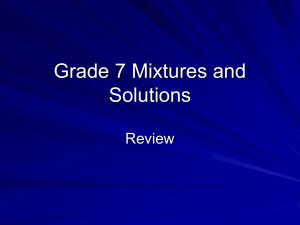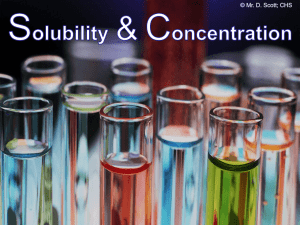Solution
advertisement
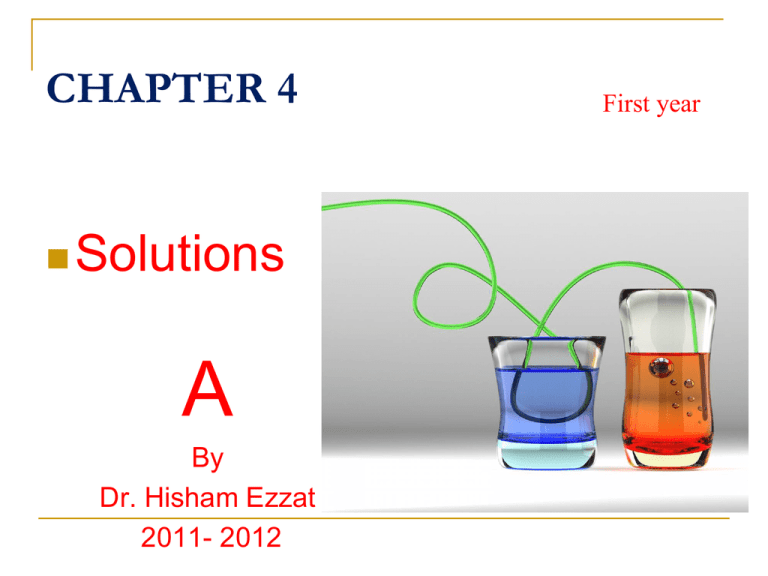
CHAPTER 4 First year Solutions A By Dr. Hisham Ezzat 2011- 2012 1 The Dissolution Process Solutions are homogeneous mixtures of two or more substances. Dissolving medium is called the solvent. Dissolved species are called the solute. There are three states of matter (solid, liquid, and gas) which when mixed two at a time gives nine different kinds of mixtures. Seven of the possibilities can be homogeneous. Two of the possibilities must be heterogeneous. 2 The Dissolution Process Solute Solid Liquid Gas Liquid Solid Gas Gas Solid Liquid Seven Homogeneous Possibilities Solvent Example Liquid salt water Liquid mixed drinks Liquid carbonated beverages Solid dental amalgams Solid alloys Solid metal pipes Gas air Two Heterogeneous Possibilities Gas dust in air Gas clouds, fog 3 Ways of Expressing Concentration Qualitative Terms: Dilute Solution – A dilute solution has a relatively small concentration of solute. A concentrated solution has a relatively high concentration of solute. 4 Quantitative Terms Quantitative expressions of concentration require specific masses, moles, or liters of the solute, solvent, or solution information regarding such quantities as The solution process: Polar materials dissolve only in polar solvents (NaCI/H2O), and non - polar substances are soluble in non - polar solvents. This is the first rule of solubility "like dissolves like" e.g: benzene in CCI 5 4 [A] Weight to Weight expression. 6 1. Weight percent (wt %) Number of grams of solute which present in 100 gram of solution. w eightof s olute mas s % x 100 totalw eightof s olution w e ig h to f s o lu t e w e ig h tf r a c t io n t o t a lw e ig h to f s o lu t io n 7 e.g. 10% by weight glucose means: 10 gm glucose + 90 gm H2O = 100 gm solution. % Solute = (10/100) x 100 = 10 %. % Solvent = (90/100) x 100 = 90 % 8 2. Mole fraction (X): 9 3. Molality Molality is a concentration unit based on the number of moles of solute per kilogram of solvent. molesof solute Molalitym kilogramsof solvent 10 N.B W solution = W solute + W solvent W solvent = W solution - W solute W solvent =dV solution - W solute Where d = density of the solution V = Volume of the solution 11 Example 1: What is the molality of 12.5 % solution of glucose C6H1206, in water? M.wt. of glucose is 180.0 Solution: 1) in 12.5 % solution 12.5 gm C6H12O6 is dissolved in l00 gm solution. W solvent = 100 - 12.5 = 87.5 g H2O 2) no. of moles glucose = 12.5/180 12 Example 2: What are the mole fractions of solute and solvent in a 1.0m aqueous solution? Solution: The molecular weight of H2O is 18.0 we find the number of moles of water in 100 gm of H2O. 1000 55.6 mol H2O no of moles of H2O 18 A 1.0 aqueous solution contains n solute =1.0 mol n H2O 55.6 n total The mole fractions are X solute n solute n total 1.0 mol 0.018 56.6 mol 55.6 0.982 n total 56.6 X water = n H2O 13 [B] Weight to Volume expression: 14 Molarity moles of solute Molarity M liters of solution 15 Example 3: a) How many grams of concentrated nitric acid solution should be used to prepare 250 ml of 2.0M HNO3? The concentrated acid is 70.0 % Solution: a) 70 gm HNO3 l00 gm solution M W 1000 x M.Wt 250 2 W 1000 x 63 250 2 x 63 x 250 Mass of pure HNO3 1000 31.5 x 100 45.0 gm mass of HNO3 solution = 70 16 b) If the density of the concentrated nitric acid solution is 1.42 g/ml. What volume should be used? M.wt. (HNO3) =63 ml cone. NHO3 = (45/1.42) = 31.7 ml cone. HNO3 17 Example 4: An aqueous solution of acetic acid was prepared by dissolving 164.2 gm of acetic acid in 800 ml of the solution. If the density of the solution was 1.026 gm/ml. M. wt of acetic acid = 60 Calculate: a) The molar concentration of the solution b) The molality c) The mole fraction of both the solute and the solvent d) The mole % e) The weight %. 18 Solution: a) W 1000 164.2x 1000 M x 3.4 M.Wtsolute Vml 60 x 800 b) d = 1.026g/ml V = 800 ml W solution = V x d = 800 x 1.026 = 820.8 gm W slvent = 820.8 - 164.2 = 656.6 gm mass 1000 164.2 x 1000 m (Solute) x 4.17 m M.Wt W(Solvent) 60 x 656.6 19 c) no. of acetic acid moles = 164.2 / 60 = 2.737 mole no. of H2O moles = 656.6 / 18 = 36.44 mole 2.737 0.0699 Mole fraction of acetic acid = 2.737 36.44 Mole fraction of H2O = 36.44 0.9299 2.737 36.44 d) mole % acetic acid = 0.0699 x 100 = 6.99 % mole % of H2O = 0.9299 x 100 = 92.99 % 164.2 x 100 e) percentage weight of acetic acid = 820.8 20 % percentage weight of H2O= 656.6 x 100 80 % 820.8 20 Try ? 1. Five grams of NaCl is dissolved in 25.0 g of H2O. What is the mole fraction of NaCl in the solution? (Answer =0.0580) 2. What is the mole percent NaCl in the previous problem 1 (Answer = 5.80 mol %) 3. Ten grams of ascorbic acid (vitamin C), C6H8O6, is dissolved in enough water to make 125 ml of solution. What is the molarity of the ascorbic acid? (Answer = 5.80 mol %) 4. What is the molality of NaCl in the solution in the previous problem 1? (Answer = 3.42 m) 5. What is the mass percent of NaCl in the solution in the previous problem 1? (Answer = 16.7 %) 21 Try ? Example 1 Five grams of NaCl is dissolved in 25.0 g of H2O. What is the mole fraction of NaCl in the solution? solution: The formula weight of NaCl is 58.44, so 5.00 g of NaCl is 22 The molecular weight of water is 18.02; so 25.0 g of H2O is In this solution, then, the mole fraction of NaCl is 0.0580. (The mole fraction of water is 1.0000 - 0.0580, or 0.9420.) 23 Example 2 What is the mole percent NaCl in the of Example 1 mol % NaCI = XNaCl X 100 = 5.80 x 10-2 x 100 = 5.80% The solution is 5.80 mol % NaCI and 94.20 mol % H2O 24
